Frequency Analysis Tools
The discrete Fourier transform (DFT) of a sequence $x[n]$ is defined as
\begin{equation} X_N[k] = DFT_N\{x[n]\} = \sum_{n=0}^{N-1}x[n]e^{-j2\pi \frac{k}{N}n},\ \ 0 \leq k \leq N-1 \end{equation}
which generates $N$ frequency samples. It is implemented in the fft() function from the scipy.fftpack package.
The length of the Fourier transform can be specified in the n parameter which defaults to the length of the sequence although it is usually set to a power of 2 to speed up computations.
For instance, given the following recording of the note Do,
we can compute and display its discrete Fourier transform as follows:
import numpy as np
import matplotlib.pyplot as plt
from scipy.io import wavfile
from scipy.fftpack import fft, ifft
fs, x = wavfile.read('do.wav')
x = x[1500:6000]
N = 8192
X = fft(x, n=N)
plt.subplot(1, 2, 1)
plt.title('Original recording x[n]')
plt.plot(x)
plt.xlabel('Number of sample')
plt.subplot(1, 2, 2)
plt.title('DFT Magnitude |X[k]|')
plt.plot(np.abs(X))
plt.xlabel('Number of sample')
- Plotting with Spyder: In order to display figures in a separate window click Tools, Preferences, Ipython Console, Graphics and under Graphics Backend select automatic instead of inline.
- Plotting with Jupyter Notebooks: You need to execute the command
%matplotlib notebookfor interactive plots or%matplotlib inlinefor static images of your plot.

Even though less samples can be taken, we select the central part of the original recording from sample 1500 to 6000 to avoid transients and we then compute the fft of n=8192 samples. Note that n can be greater than the length of the analyzed segment as the function takes care of the zero padding.
From the result, its the harmonic structure is clear: we observe spectral lines equidistant in frequency. The separation between spectral lines is equal to the frequency at which the first peak appears, at around the 535th sample, which corresponds to the analogic frequency of
\begin{equation} f_0 = F_0 \cdot f_s = \frac{535}{N}\cdot f_s = \frac{535}{8192}\cdot 4000Hz = 261.2 Hz \end{equation}
and matches with the fundamental frequency of the Do note at $262Hz$. Indeed, if we wish to plot the magnitude of the discrete time Fourier transform versus the analog frequency instead of the sample number we just need to do:
plt.plot(np.arange(N)/N * fs, np.abs(X))
Note that the analog frequency corresponding the last sample of the DFT is (N-1)/N * fs since np.arange(N) generates N samples in the interval [0, N).
In order to obtain the argument of the transform we can use np.angle(X) and we can apply the inverse discrete Fourier transform in the ifft() function in such a way that ifft(fft(x)) returns the analyzed segment.
Fourier Transform in 2D
The extension to the 2-dimensional case of the discrete Fourier transform is defined as
\begin{equation} X[k, l] = \sum_{m=0}^{M-1} \sum_{n=0}^{N-1} x[m,n]e^{-j2\pi \frac{k}{M}m \frac{l}{N}n},\ \ 0 \leq k \leq M-1,\ \ 0 \leq l \leq N-1 \end{equation}
and it is available in the fft2() function from the scipy.fftpack package.
Usually, we represent the magnitude with a logarithmic transform due to its dynamic range. Since images are generally positive signals, the highest value
of the magnitude of their transform is at $(k,l) = (0, 0)$. Given the DFT symmetries, the four corners of the transformed image contain the highest values of the magnitude. In order to help visualizing, the transformed image is represented centered at $(M/2, N/2)$ by means of the fftshift() function. Hence, the DC component, i.e. the value at $(k,l) = (0, 0)$ appears at the center of the transform.
For instance, for the following 2D pulse signal (or rectangular window),
L = 500
x = np.zeros((L, L))
x[100:400, 240:260] = 1
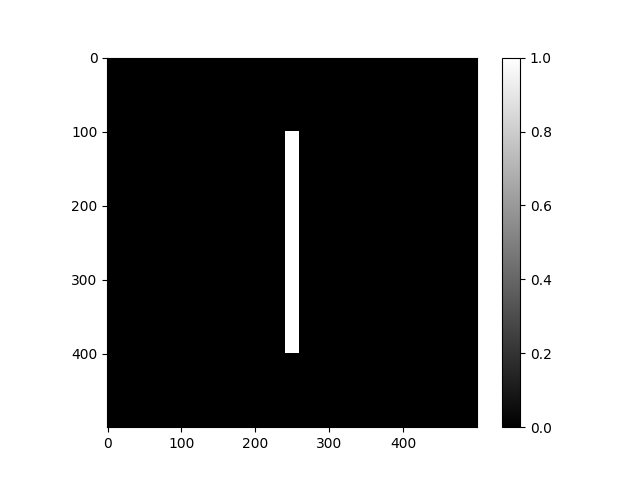
we can represent the magnitude of its 2D DFT as follows:
from scipy.fftpack import fft2, fftshift
X = fftshift(fft2(x))
plt.imshow(np.log10(1 + np.abs(X)), cmap='jet')
plt.colorbar()
plt.title('DFT Magnitude')
plt.xlabel('F1')
plt.ylabel('F2')
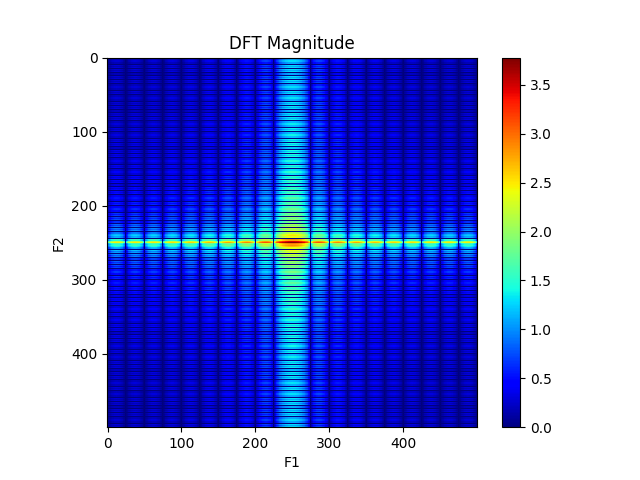
Moreover, we can visualize this figure in 3 dimensions by means of the code below:
from mpl_toolkits.mplot3d import Axes3D
F1 = np.linspace(-0.5, 0.5, L)
F2 = np.linspace(-0.5, 0.5, L)
F1, F2 = np.meshgrid(F1, F2)
fig = plt.figure()
ax = fig.gca(projection='3d')
ax.plot_surface(F1, F2, np.log10(1 + np.abs(X)), cmap='jet')
ax.set_xlabel('F1')
ax.set_ylabel('F2')
ax.set_zlabel('DFT Magnitude')
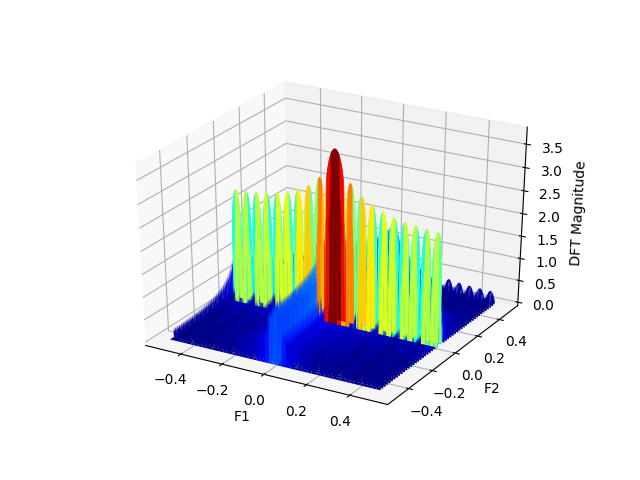
Finally, it is worth illustrating the transform on a real image such as the cameraman:
x = plt.imread('camera.png')
X = fftshift(fft2(x))
plt.subplot(1, 2, 1)
plt.imshow(x, cmap='gray')
plt.subplot(1, 2, 2)
plt.imshow(np.log10(1 + np.abs(X)), cmap='gray')
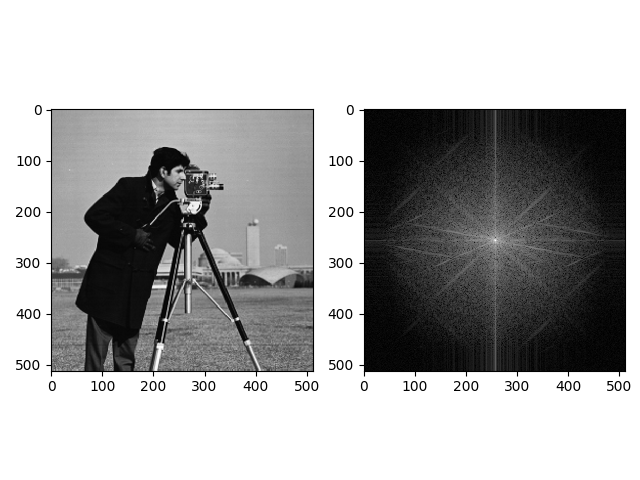
Short Time Fourier Transform
The Short Time Fourier Transform (STFT) is defined to handle non-stationary signals that change their frequency properties through time. It consists on using a shifted window $v[n]$ of length $L$ that allows the local analysis of the signal through it:
\begin{equation} X[m, F] = \sum_{n = -\infty}^{n = \infty} x[n]v[n-mR]e^{-j2\pi Fn} \end{equation}
In this formula,
$m$ indexes the window (frame number)
$R$ defines the distance between two consecutive windows (hop size)
These variables can be customised in the stft() function from the scipy.signal package by means of these parameters:
npersecdefines the length $L$ of the windownoverslapstands for the number of points to overlap between frames, i.e. $L-R$, which is by default $L/2$
Moreover, the parameter fs sets the sampling frequency used in the time signal and window allows to specify the window $v[n]$ which defaults to the Hanning window. In order to explore the capabilities of the STFT, we will load the following 5 second recording of two consecutive piano chords
and we will first set the window length to nperseg=128:
from scipy.signal import stft
fs, chords = wavfile.read('chords.wav')
f, t, spectrogram = stft(chords, fs, nperseg=128)
plt.figure()
plt.pcolormesh(t, f, 10*np.log10(np.abs(spectrogram)**2))
plt.title('Spectrogram')
plt.ylabel('Frequency (Hz)')
plt.xlabel('Time (s)')
plt.colorbar().set_label('Power/frequency (dB/Hz)')
plt.show()
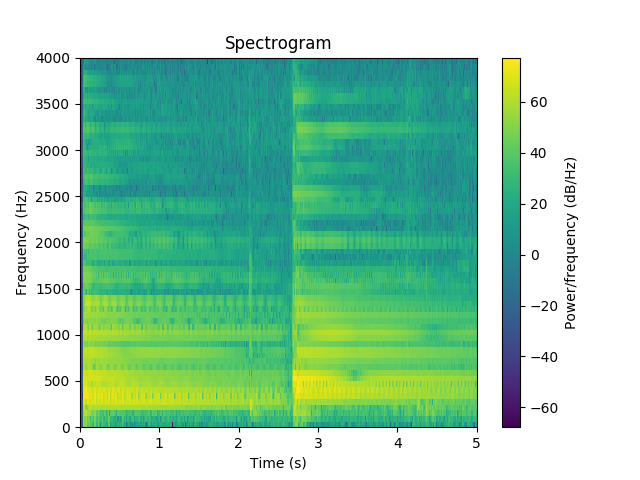
We observe that the frequency resolution is poor whereas we can clearly identify the moment of change in the chords. If we now change the window length to nperseg=1024,
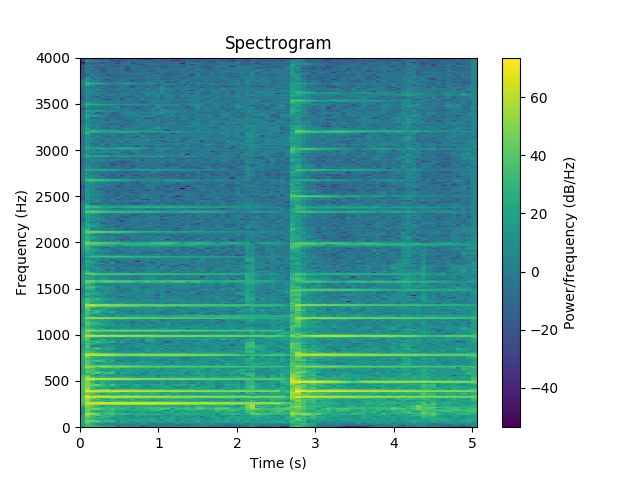
the harmonics of the different notes become crystal clear and we realise that the high frequency ones decay faster. Finally, based on the following musical note to frequency conversion chart,
| Musical Note | Frequency | |
|---|---|---|
| Do | $C_4$ | $262\ Hz$ |
| Re | $D_4$ | $294\ Hz$ |
| Mi | $E_4$ | $330\ Hz$ |
| Fa | $F_4$ | $349\ Hz$ |
| Sol | $G_4$ | $392\ Hz$ |
| La | $A_5$ | $440\ Hz$ |
| Si | $B_5$ | $494\ Hz$ |
we conclude that the two chords were Do, Mi, Sol and Mi, Sol, Si.
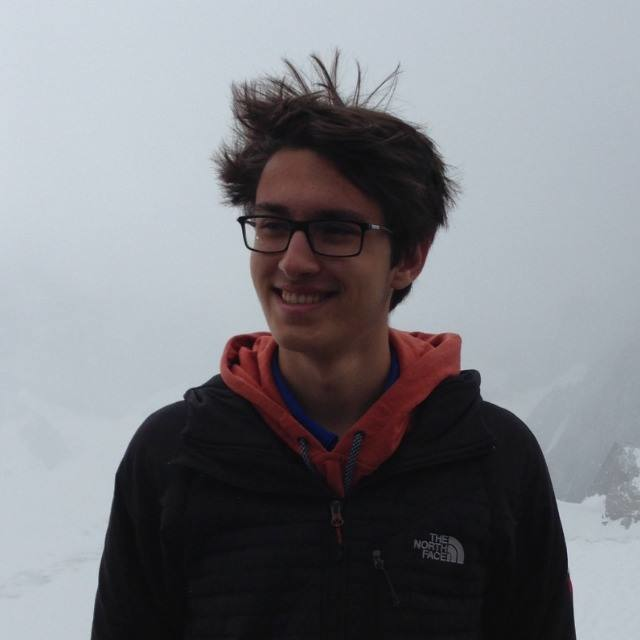 Lliçons.jutge.org
Lliçons.jutge.org
Víctor Adell
Universitat Politècnica de Catalunya, 2023
Prohibit copiar. Tots els drets reservats.
No copy allowed. All rights reserved.